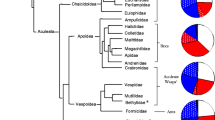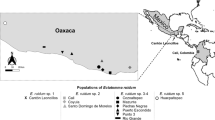Abstract
Epicuticular hydrocarbon variation was investigated among the three species of the Drosophila mojavensis cluster (D. mojavensis, D. arizonae, and D. navojoa) within the large D. repleta group. Because these hydrocarbons serve as contact pheromones in adult D. mojavensis, the chemical characteristics and differences in hydrocarbon profiles in populations of these three sibling species were further investigated. Twenty-seven hydrocarbon components with chain lengths ranging from C28 to C40, including n-alkanes, methyl-branched alkanes, n-alkenes, methyl-branched alkenes, and alkadienes were observed. Hydrocarbon profiles among the three species reared on different cactus hosts were easily aligned with previously identified components in D. mojavensis. Male and female D. navojoa possessed a 31-methyldotricont-6-ene absent in both D. arizonae and D. mojavensis, while lacking the 8,24-tritricontadiene present in these two species. D. navojoa adults had far less 2-methyloctacosane than these sibling species, but the significance of this difference was obscured by the degree of variation among populations in amounts of this hydrocarbon. Mainland and Baja California populations of D. mojavensis were fixed for differences in the amounts 8,24-tritricontadiene, 9,25-pentatricontadiene, and 9,27-heptatricontadiene, consistent with all previous studies. Amounts of 18 of the 27 hydrocarbon components were greater in flies reared on Opuntia cactus. Canonical discriminant function analysis resolved all three species into distinct, nonoverlapping groups, suggesting that epicuticular hydrocarbon profiles are species-specific in the D. mojavensis cluster. Based on the amounts of interpopulation variation in hydrocarbon profiles in these three species, we hypothesize that epicuticular hydrocarbon differences may evolve early during the formation of new species.
Similar content being viewed by others
REFERENCES
ALCORN, S. M., ORUM, T. V., STEIGERWALT, A. G., FOSTER, J. L. M., FOGLEMAN, J. C., and BRENNER, D. J. 1991. Taxonomy and pathogenicity of Erwinia cacticida sp. nov. Int. J. Syst. Bacteriol. 41:197-212.
ANTONY, C. and JALLON, J.-M. 1982. The chemical basis for sex recognition in Drosophila melanogaster. J. Insect Physiol. 28:873-880.
BOAKE, C. R. B., DEANGELIS, M. P., and ANDREADIS, D. K. 1997. Is sexual selection and species recognition a continuum? Mating behavior of the stalk-eyed fly Drosophila heteroneura. Proc. Natl. Acad. Sci. U.S.A. 94:12442-12445.
BRAZNER, J. C., and ETGES, W. J. 1993. Pre-mating isolation is determined by larval rearing substrates in cactophilic Drosophila mojavensis. II. Effects of larval substrates on time to copulation, mate choice, and mating propensity. Evol. Ecol. 7:605-624.
BYRNE, C. 1999. Behaviour-genetic analysis of lovesongs in desert species of Drosophila. PhD dissertation. University of Leicester, Leicester, UK.
CARSON, H. L. 2000. Sexual selection in populations: The facts require a change in the genetic definition of the species, pp. 495-512, in R. S. Singh and C. Krimbas (eds.). Evolutionary Genetics: From Molecules to Morphology. Cambridge University Press, New York.
COYNE, J. A., and ORR, H. A. 1989. Patterns of speciation in Drosophila. Evolution 43:362-381.
COYNE, J. A., CRITTENDEN, A. P., and MAH, K. 1994. Genetics of a pheromonal difference contributing to reproductive isolation in Drosophila. Science 265:1461-1464.
DOBZHANSKY, T. 1951. Genetics and the Origin of Species. Columbia University Press, New York.
DURANDO, C. M., BAKER, R. H., ETGES, W. J., HEED, W. B., WASSERMAN, M., and DESALLE, R. 2000. Phylogenetic analysis of the repleta species group of the genus Drosophila using multiple sources of characters. Mol. Phylogenet. Evol. 16:296-307.
EHRMAN, L. 1990. Developmental isolation and subsequent adult behavior of Drosophila pseudoobscura. Behav. Genet. 20:609-615.
ETGES, W. J. 1990. Direction of life history evolution in Drosophila mojavensis, pp. 37-56, in J. S. F. Barker, W. T. Starmer, and R. J. MacIntyre (eds.). Ecological and Evolutionary Genetics of Drosophila. Plenum Press, New York.
ETGES, W. J. 1992. Premating isolation is determined by larval substrates in cactophilic Drosophila mojavensis. Evolution 46:1945-1950.
ETGES, W. J. 1993. Genetics of host-cactus response and life-history evolution among ancestral and derived populations of cactophilic Drosophila mojavensis. Evolution 47:750-767.
ETGES, W. J. 1998. Premating isolation is determined by larval rearing substrates in cactophilic Drosophila mojavensis. IV. Correlated responses in behavioral isolation to artificial selection on a life history trait. Am. Nat. 152:129-144.
ETGES, W. J. and AHRENS, M. A. 2001. Premating isolation is determined by larval rearing substrates in cactophilic Drosophila mojavensis. V. Deep geographic variation in epicuticular hydrocarbons among isolated populations. Am. Nat. In press.
ETGES, W. J. and HEED, W. B. 1987. Sensitivity to larval density in populations of Drosophila mojavensis: Influences of host plant variation on components of fitness. Oecologia 71:375-381.
ETGES, W. J. and KLASSEN, C. S. 1989. Influences of atmospheric ethanol on adult Drosophila mojavensis: Altered metabolic rates and increases in fitness among populations. Physiol. Zool. 62:170-193.
ETGES, W. J., JOHNSON, W. R., DUNCAN, G. A., HUCKINS, G., and HEED, W. B. 1999. Ecological genetics of cactophilic Drosophila, pp. 164-214, in R. Robichaux (ed.). Ecology of Sonoran Desert Plants and Plant Communities. University of Arizona Press, Tucson, Arizona.
EWING, A. W. and MIYAN, J. A. 1986. Sexual selection, sexual isolation and the evolution of song in the Drosophila repleta group of species. Anim. Behav. 34:421-429.
FANARA, J. J., FONTDEVILA, A., and HASSON, E. 1999. Oviposition preference and life history traits in cactophilic Drosophila koepferae and D. buzzatti in association with their natural hosts. Evol. Ecol. 13:173-190.
FELLOWS, D. P. and HEED, W. B. 1972. Factors affecting host plant selection in desert-adapted cactophilic Drosophila. Ecology 53:850-858.
FERVEUR, J.-F., SAVARIT, F., O'KANE, C. J., SUREAU, G., GREENSPAN, R. J., and JALLON, J.-M. 1997. Genetic feminization of pheromones and its behavioral consequences in Drosophila males. Science 276:1555-1558.
FOGLEMAN, J. C. and ABRIL, J. R. 1990. Ecological and evolutionary importance of host plant chemistry, pp. 121-141, in J. S. F. Barker, W. T. Starmer, and R. J. MacIntyre (eds.). Ecological and Evolutionary Genetics of Drosophila. Plenum Press, New York.
FOGLEMAN, J. C. and HEED, W. B. 1989. Columnar cacti and desert Drosophila: The chemistry of host plant specificity, pp. 1-24, in J. O. Schmidt (ed.). Special Biotic Relationships of the Southwest. University of New Mexico Press, Albuquerque, New Mexico.
FONTDEVILA, A., WASSERMAN, M., PLA, C., PILARES, L., ARMENGOL, R. D., SUYO, M. D. P., SANCHEZ, A., VASQUEZ, J., RUIZ, A., and GARCIA, J. L. 1990. Description and evolutionary relationships of two species of the Drosophila mulleri cluster (Diptera: Drosophilidae). Ann. Entomol. Soc. Am. 83:444-452.
HEED, W. B. 1982. The origin of Drosophila in the Sonoran Desert, pp. 65-80, in J. S. F. Barker and W. T. Starmer (eds.). Ecological Genetics and Evolution: The Cactus-Yeast-Drosophila Model System. Academic Press, Sydney.
HEED, W. B. and MANGAN, R. L. 1986. Community ecology of the Sonoran Desert Drosophila, pp. 311-345, in M. Ashburner, H. L. Carson, and J. J. N. Thompson (eds.). The Genetics and Biology of Drosophila. Academic Press, New York.
JALLON, J.-M. 1984. A few chemical words exchanged during courtship and mating of Drosophila melanogaster. Behav. Genet. 14:441-478.
JOHNSON, W. R. 1980. Chromosomal polymorphism in natural populations of the desert adapted species, Drosophila mojavensis. PhD dissertation. University of Arizona, Tucson Arizona.
KIM, Y. K. and EHRMAN, L. 1998. Developmental isolation and subsequent adult behavior of Drosophila paulistorum. IV. Courtship. Behav. Genet. 28:57-65.
KIM, Y.-K., KOEPFER, H. R., and EHRMAN, L. 1996. Developmental isolation and subsequent adult behaviour of Drosophila paulistorum. III. Alternative rearing. Behav. Genet. 26:27-37.
MARKOW, T. A. and MAVEETY, N. 1985. More character displacement for reproductive isolation in the mulleri complex. Dros. Inf. Serv. 61:115.
MARKOW, T. A. and TOOLSON, E. C. 1990. Temperature effects on epicuticular hydrocarbons and sexual isolation in Drosophila mojavensis, pp. 315-331, in J. S. F. Barker, W. T. Starmer, and R. J. MacIntyre (eds.). Ecological and Evolutionary Genetics of Drosophila. Plenum Press, New York.
MARKOW, T. A. FOGLEMAN, J. C., and HEED, W. B. 1983. Reproductive isolation in Sonoran Desert Drosophila. Evolution 37:649-652.
MASTERS, J. C. 2000. The role of selection in speciation, pp. 513-531, in R. S. Singh and C. Krimbas (eds.). Evolutionary Genetics: From Molecules to Morphology. Cambridge University Press, New York.
NEMOTO, T., DOI, M., OSHIO, K., MATSUBAYASHI, H., OGUMA, Y., SUZUKI, T., and KUWAHARA, Y. 1994. (Z,Z)-5,27-Tritriacontadiene: Major sex pheromone of Drosophila pallidosa (Diptera: Drosophilidae). J. Chem. Ecol. 20:3029-3037.
NOOR, M. A. 1995. Speciation driven by natural selection in Drosophila. Nature 375:674-675.
NOOR, M. A. F. 1999. Reinforcement and other consequences of sympatry. Heredity 83:503-508.
OGUMA, Y., NEMOTO, T., and KUWAHARA, Y. 1992a. (Z)-11-Pentacosene is the major sex pheromone component in Drosophila virilis. Chemoecology 3:60-64.
OGUMA, Y., NEMOTO, T., and KUWAHARA, Y. 1992b. A sex pheromone study of a fruit-fly Drosophila virilis Sturtevant (Diptera: Drosophilidae): Additive effect of cuticular alkadienes to the major sex pheromone. Appl. Entomol. Zool. 27:499-505.
PATERSON, H. E. H. 1993. Evolution and the Recognition Concept of Species: Collected Writings. Johns Hopkins University, Baltimore, Maryland.
RUIZ, A. and HEED, W. B. 1988. Host-plant specificity in the cactophilic Drosophila mulleri species complex. J. Anim. Ecol. 57:237-249.
RUIZ, A., HEED, W. B., and WASSERMAN, M. 1990. Evolution of the mojavensis cluster of cactophilic Drosophila with descriptions of two new species. J. Hered. 81:30-42.
SAS INSTITUTE, I. 1989. SAS/STAT User's Guide, Version 6. SAS Institute Inc., Cary, North Carolina.
SAUER, J. R. and WILLIAMS, B. K. 1989. Generalized procedures for testing hypotheses about survival or recovery rates. J. Wildl. Manage. 53:137-142.
SPIETH, H. T. 1974. Courtship behavior in Drosophila. Annu. Rev. Entomol. 19:385-405.
STALKER, H. D. 1942. Sexual isolation studies in the species complex Drosophila virilis. Genetics 27:238-257.
STARMER, W. T. 1982. Analysis of community structure of yeasts associated with the decaying stems of cactus. I. Stenocereus gummosus. Microb. Ecol. 8:71-81.
STENNETT, M. D. and ETGES, W. J. 1997. Pre-mating isolation is determined by larval rearing substrates in cactophilic Drosophila mojavensis. III. Epicuticular hydrocarbon variation is determined by use of different host plants in Drosophila mojavensis and Drosophila arizonae. J. Chem Ecol. 23:2803-2824.
TOOLSON, E. C., MARKOW, T. A., JACKSON, L. L., and HOWARD, R. W. 1990. Epicuticular hydrocarbon composition of wild and laboratory-reared Drosophila mojavensis Patterson and Crow (Diptera: Drosophilidae). Ann. Entomol. Soc. Am. 83:1165-1176.
WASSERMAN, M. 1992. Cytological evolution of the Drosophila repleta species group, pp. 455-552, in C. B. Krimbas and J. R. Powell (eds.). Drosophila Inversion Polymorphism. CRC Press, Boca Raton, Florida.
WASSERMAN, M. and KOEPFER, H. R. 1977. Character displacement for sexual isolation between Drosophila mojavensis and Drosophila arizonensis. Evolution 31:812-823.
ZOUROS, E. and D'ENTREMONT, C. J. 1980. Sexual isolation among populations of Drosophila mojavensis: Response to pressure from a related species. Evolution 34:421-430.
Author information
Authors and Affiliations
Rights and permissions
About this article
Cite this article
Etges, W.J., Jackson, L.L. Epicuticular Hydrocarbon Variation in Drosophila mojavensis Cluster Species. J Chem Ecol 27, 2125–2149 (2001). https://doi.org/10.1023/A:1012203222876
Issue Date:
DOI: https://doi.org/10.1023/A:1012203222876




